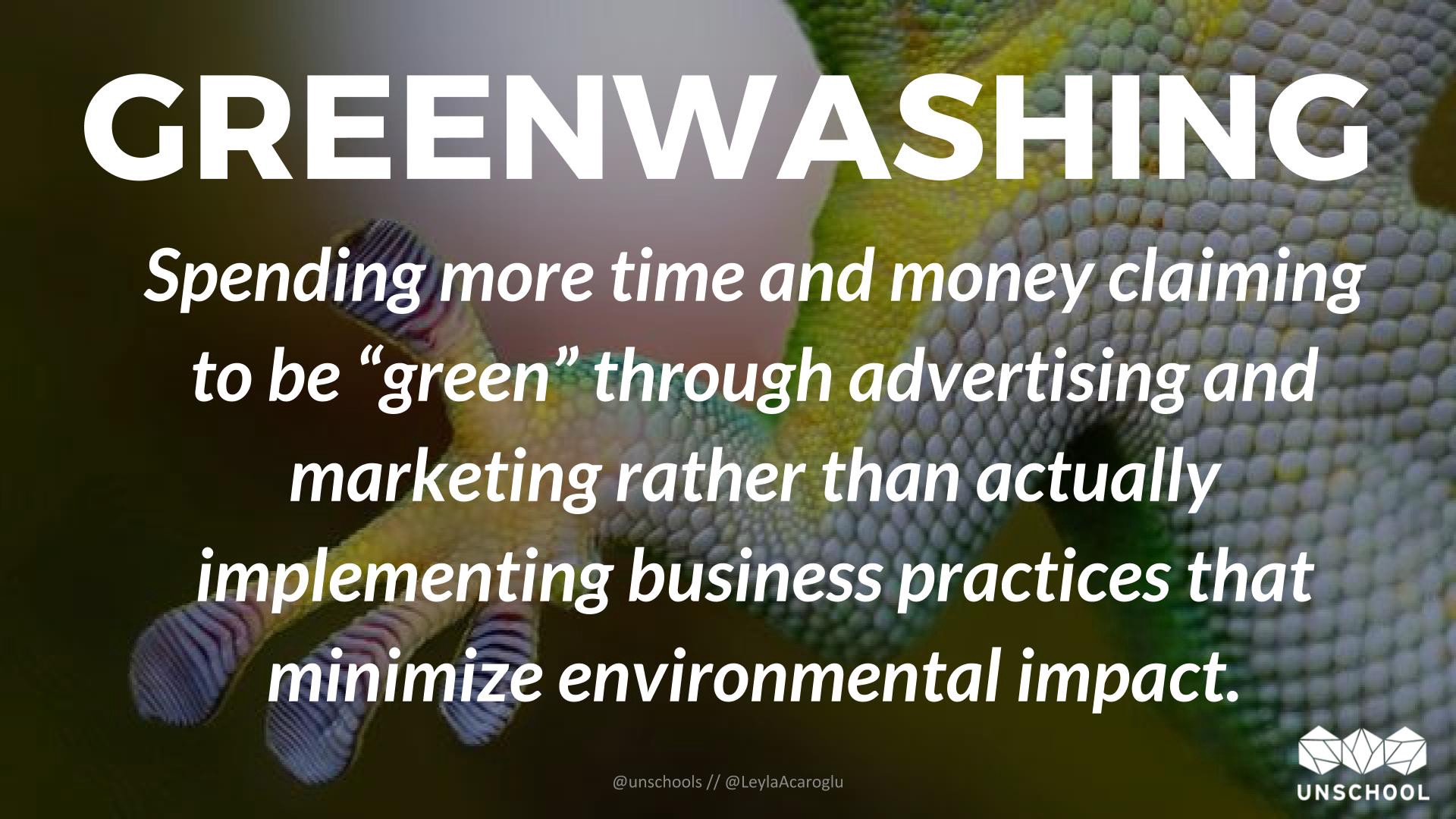
In our hyper-consumption based societies, it?s always smart to raise a skeptical eyebrow when you hear organizations make claims of how they?re ?doing their part? in the quest to ?save the Earth?, (although at the UnSchool we truly believe that no one can ?save? the Earth, but we can all change it!). But when companies invest more time and money on marketing their products or brand as ?green? rather than actually doing the hard work to ensure that it is sustainable ? this is called greenwashing.
Cambridge Dictionary says greenwashing is designed ?to make people believe that your company is doing more to protect the environment than it really is.?
As an analogy, greenwashing is to corporations as tree hugging is to individuals who say they care about the environment, it?s a symbolic reference that has little actual outcomes. And more so just confuses the issue attempting to be resolved.

Whilst some greenwashing is unintentional and results from a lack of knowledge about what sustainability truly is, it is often intentionally carried out through a wide range of marketing and PR efforts. But the common denominator among all greenwashing is that it is not only misleading, but it?s also really not helping to further sustainable design or circular economy initiatives. Thus, environmental problems stay the same or more likely, get even worse, as greenwashing often sucks up airtime and misdirects well-intentioned consumers down the wrong path.
One such classic greenwashing case is that of the car giant Volkswagen, who has admitted to cheating emissions tests by fitting various vehicles with a ?defeat? device ? a proprietary software that could detect when it was undergoing an emissions testing, altering the performance to reduce the emissions level, all while touting the low-emissions features of its vehicles through marketing campaigns. In truth, however, these engines were emitting up to 40x the allowed limit for nitrogen oxide pollutants.
There are countless other case studies across all industries that show how NOT to do sustainability by discovering more examples of greenwashing ? like the meat mega-giant Tyson, who got busted for false claims about antibiotic-free chickens. Or the fossil fuel giant BP (who changed their name to Beyond Petroleum and put solar panels on their gas stations) and then got called out for their green misdirection, and of course Coke, who has been accused of greenwashing through ?natural? sugar claims that it started marketing as a way to attract more health-conscious consumers.
Years ago the design agency Futerra made a really cool resource called the Sins of Greenwashing, which classifies the many ways that companies participate in greenwashing, from outright lying through to making claims with no scientific proof. This is one of the reasons that life cycle thinking is such an important tool to know how to access and use when making sustainable design choices, because many people who get caught greenwashing are often not intentionally doing it, but more so are ill-informed of the impacts of different materials. They thus end up accidentally making unsubstantiated claims about environmental preferences, or worse still making assumptions about what is green or not based on environmental folklore or simple google searching!
GREENWASHING AND SINGLE-USE PLASTICS
One of the most pervasive examples of greenwashing is in the world of single-use plastic. Did you know that half of the worlds disposable plastic has been produced in the last 15 years! And 91% of plastic produced globally is NOT recycled. You have probably already heard of the global plastic-in-the-ocean-disaster we are seeing, with stats that say there will be more plastic than fish in the ocean by 2050 and the horrific images of once pristine beaches being overwhelmed by plastic debris. It?s no wonder the world is up in arms about this tragic by-product of our disposable lifestyles.
This alarming issue drove us to create our free Post-Disposable Activation Kit, and it?s why we talk so much about the dangerous idea that recycling will solve all the problems, when in fact the main issue is that we have normalized disposability to the point where everything is valueless. And not only is recycling a bit of environmental folklore, but so are many of the bioplastics being marketed as sustainable design solutions.
Bioplastics are plastics made from bio based polymers that are engineered to perform like normal petrochemical plastics. In nearly every case, they need a certain set of conditions to break down in (oxygen and sunlight that aren?t present in a landfill or the ocean, for example). Further to the end of life management issues, they also require a certain amount of petrochemicals in their production phase so often have a similar amount of ?plastic products? embedded within them. Additionally, since plastic bags take a lot of energy and other resources to manufacture in the first place, a ?friendlier? plastic is not helpful at all when using life-cycle thinking. The FTC began cracking down on the misleading claims of bioplastic manufacturers in 2013 and handed out more warnings to marketers in 2014.
This was the case in Australia years ago when a plastic bag company swapped to ?biodegradable? plastic, which technically didn?t fully degrade, but instead just breaks down into smaller parts unless it?s processed in a digester specifically designed to create the conditions for biodegradation. What is actually needed is a compostable bag, which is a different thing entirely. The bag made big eco claims, and the consumer affairs watchdog fined them and required them to stop selling the product as it was completely false. In fact, Australia has this entire guide on how to avoid greenwashing!
As consumers, we have the power to see through the greenwashing and calling bullshit where it?s due, rather then falling into the safe belief that there are simple solutions to complex problems. We can continue to pressure corporations to create truly viable, post-disposable, sustainable and circular design solutions by changing our own habits and behaviours to support the more sustainable options. We believe that all of these problems are solvable with good design, a systems mindset, and services that reconfigure how we meet our human needs without damaging Earth in the process. If you want to participate in the global post-disposable redesign challenge, check out this set of design briefs that we created.
BUST MORE ECO-MYTHS
Greenwashing is all about misdirection, showing one thing that distracts you from what is really going on. The main issue we see is that greenwashing takes up valuable space in the fight against significant environmental issues like climate change, plastic ocean pollutions, air pollution and global species extinctions. The saddest thing is that many companies do it by accident, as they don?t have the expertise to know what is truly environmentally beneficial, and what is not.
We are approaching a critical time in which more organizations and individuals are adopting sustainable design and zero waste living practices, and entire communities are banning disposable plastics, It?s important to be able to quickly identify instances of greenwashing, and replace them with truly sustainable practices both as a consumer and as an employee (which the UnSchool sustainability course covers in more detail). Tools such as life cycle assessment allow organisations to understand what is going on when they make changes and to ensure that if they make claims about the eco credentials that they are validated, not just assumed.
THIS IS A TIME OF ABUNDANT OPPORTUNITIES.
We all can be change agents in considering and designing sustainable outcomes in the world around us that affect systemic wellbeing ? socially, economically, and environmentally. When we frame sustainability as a practice that helps us create a future that we?re excited about living in, we generate optimism about solving complex problems (which is what?s required to truly tackle these issues!).
Pair that with creative thinking, knowledge of systems and life cycle thinking, and a foundation built on what sustainable design in practice really looks like, and we?ll have tangible outcomes that are positively disrupting the status quo and affecting change. The key here is for more people to adopt the tools of change, not just follow along with the trends, but be willing to do the work to understand what needs to change.
? ? ? –
This article is part of the UnSchool Journal series, sign up here to receive articles like this in your inbox every week.
At the UnSchool we are dedicated to helping people make a positive impact and increase capacity to make more effective change-making decisions for a sustainable and regenerative planet, we now have an UnMasters track to get certified by the UnSchool as a professional creative change-maker.


